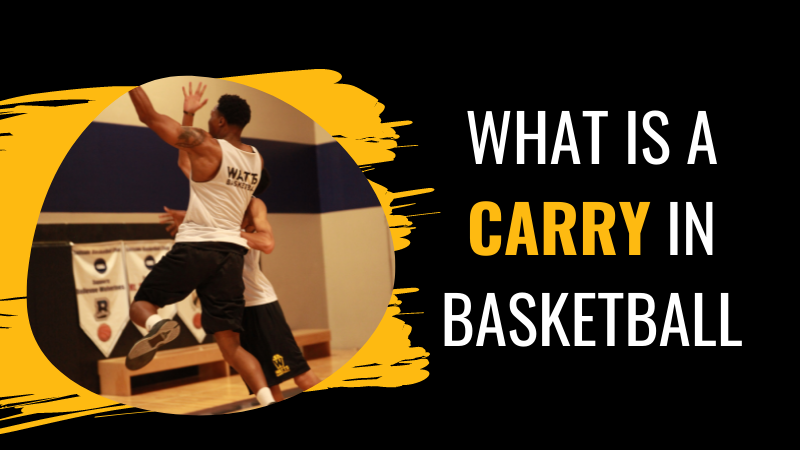What is a carry in basketball? Carrying, which is defined as the illegal act of carrying or dribbling a live ball, occurs after the dribbler allows the ball to come to rest in either hand before continuing to dribble. It is similar to holding or double-dribbling because in both cases, the ball has stopped moving and is then bounced again. Take a look at this basketball term on a deeper level by reading below.
Hoops Lingo: Learning What is a Carry in Basketball
In the game of basketball, dribbling is the license that allows you to navigate across the court without getting called for a violation. However, obstacles in the form of pesky defenders would attempt to stop you in your tracks and force a turnover. Now one of the most common infractions a ball handler commits is a carry. And in the road towards becoming an efficient dribbler, here is what you need to know about this violation.
Definition of a carry
What is a carry in basketball? Carrying the basketball is one of the most common violations in basketball and is considered to be almost entirely unintentional. It is usually called when a player dribbling the basketball has their hand underneath it as they dribble the ball but then briefly pauses without dribbling or bringing the ball below their waist. This act catches referees off-guard and they end up calling a carrying violation. Most players who carry don’t have any idea they’re doing it, so it’s important for players to realize this so that they can avoid making these silly mistakes.
The act of carrying the basketball may be considered legal within the laws of the game. However, there are specific rules concerning where and how the ball can be handled. If a player carries the ball into the opposing team’s territory, this is considered a foul. Fouls are called on both teams equally and both team’s foul shooters are given five free throws. If a player successfully makes two free throws then he/she is awarded one point. However, if a player fails to make any free throws at all then he/she receives one point. A player cannot be called for carrying in four consecutive minutes while the game is in progress.

ART OF SHOOTING
Learn to be an elite shooter with this Art of Shooting Worksheet – written for serious players, by Coach Watts who led the PAC-12 in 3pt shooting percentage and was UW’s leading scorer.
Types of carry
Carrying can either be considered a double dribble or a travel. Depending on what happens during the carrying infraction will dictate which one.
Double-dribble
A double dribble is a violation in basketball that occurs when the ball handler continues to dribble after one or both hands come in contact with the ball but does not dribble it beyond his/her head. This is a clear violation of the rule that states the player must dribble with “continual motion” and cannot stop, pick up the dribble, and start again. If a player does this, then they are guilty of committing a double dribble.
What is a carry in basketball states that double dribble in basketball can occur when the dribbler is holding the ball, and the ball comes to rest in his hand while it is still dribbled. If the player continues dribbling, it is considered a carry. It may be possible that the referee rules a double dribble because the player had stopped his dribble, but proceeded by dribbling again.
Palming the ball while dribbling
Traveling is when the offensive player in possession of the ball moves with his/her feet while keeping the ball high enough (can be held off the floor). When a player travels, the referee will stop play and call a violation. A traveling violation is committed when a player takes more than two steps without dribbling or performs a dribble without keeping both feet on the floor.
If a player’s hand is on the lower half of the ball while the player is still moving, traveling has been committed. This can be called a carry or traveling, as both are considered this violation. It may be just one dribble and then you may have a carry/travel or it may be many dribbles before it is called a travel. The important thing to remember is that if the hand touches the bottom of the ball when it has come to a brief stop and the dribble continues, that could be considered traveling.
Familiarize yourself with the rules on the court!
How to prevent carry
There are several rules players need to keep in mind when carrying the ball. The dribble must be continuous, with no stopping, hesitation, or pausing in between. Players are also required to have their palms facing downwards at all times when carrying the ball and have two hands on the ball at all times unless shooting. Carrying will be called at every level of basketball. It is called more often in semi-pro and professional leagues than in youth leagues.
To stop being called for a foul, ball handlers must limit their motions to the minimum required to avoid being pushed off balance. They also must maintain control of the ball throughout its duration in flight. This means that the player will have to quickly adjust his momentum and change directions as needed when attacking the basket or receiving a pass near the hoop. The best form of defense for any player that receives a lot of fouls is practice.
How to force an offensive player to carry
How to force an offensive player to carry in basketball is a question that often comes up on message boards and in the living rooms of basketball enthusiasts. Most people seem to believe that the best way to play defense is to constantly be in an opponent’s face and drive him crazy with constant switching and fake pushes/crossovers. But this obviously plays into the tendencies of many players who prefer to drive until they run out of gas and then change directions when they can’t get an open look.
The best way to alter the physical dimensions of the court and the dimensions of a basket is to force the offensive player to carry the ball. Such an action is not normally successful when the attacking player is several feet shorter than his defensive partner. This is because most small players are not tall enough to reach the top of the backboard when carrying the ball. And since most big men are not particularly muscular or powerful, they lack the upper body strength necessary to keep their balance when carrying the ball.
Put the Ball in a String
What is a carry in basketball seems like a challenging act to familiarize yourself with. However, as a basketball player, it is very important to know the different types of foul that you might get yourself into. This way, you can avoid committing mistakes and making more shots in the court.

